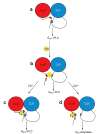How calmodulin interacts with the adenosine A(2A) and the dopamine D(2) receptors
- PMID: 18590318
- PMCID: PMC2538563
- DOI: 10.1021/pr8001782
How calmodulin interacts with the adenosine A(2A) and the dopamine D(2) receptors
Abstract
Receptor heteromerization is a mechanism used by G protein-coupled receptors to diversify their properties and function. We previously demonstrated that these interactions occur through salt bridge formation between epitopes of the involved receptors. Recent studies claim that calmodulin (CaM) binds to an Arg-rich epitope located in the amino-terminus of the dopamine D(2) receptor third intracellular loop. This is the same epitope involved in adenosine A(2A)-D(2) receptor heteromerization, through Coulombic interaction between the Arg residues and a phosphorylated serine (pS) located in the medial segment of the C-terminus of the A(2A) receptor. Mass spectrometric analysis indicates that an electrostatic interaction involving the D(2) receptor Arg-rich epitope and several CaM acidic epitopes are mainly responsible for the D(2) receptor-CaM binding. CaM could also form multiple noncovalent complexes by means of electrostatic interactions with an epitope localized in the proximal segment of the C-terminus of the A(2A) receptor. Ca(2+) disrupted the binding of CaM to the D(2) but not to the A(2A) receptor epitope, and CaM disrupted the electrostatic interactions between the D(2) receptor epitope and the more distal A(2A) receptor epitope. A model is introduced with the possible functional implications of A(2A)-D(2)-CaM interactions. These in vitro findings imply a possible regulatory role for CaM in receptor heteromers formation.
Figures





Similar articles
-
Interactions between calmodulin, adenosine A2A, and dopamine D2 receptors.J Biol Chem. 2009 Oct 9;284(41):28058-28068. doi: 10.1074/jbc.M109.034231. Epub 2009 Jul 24. J Biol Chem. 2009. PMID: 19632986 Free PMC article.
-
Role of electrostatic interaction in receptor-receptor heteromerization.J Mol Neurosci. 2005;26(2-3):125-32. doi: 10.1385/JMN:26:2-3:125. J Mol Neurosci. 2005. PMID: 16012186
-
Combining mass spectrometry and pull-down techniques for the study of receptor heteromerization. Direct epitope-epitope electrostatic interactions between adenosine A2A and dopamine D2 receptors.Anal Chem. 2004 Sep 15;76(18):5354-63. doi: 10.1021/ac049295f. Anal Chem. 2004. PMID: 15362892
-
Adenosine A2A-dopamine D2 receptor-receptor heteromers. Targets for neuro-psychiatric disorders.Parkinsonism Relat Disord. 2004 Jul;10(5):265-71. doi: 10.1016/j.parkreldis.2004.02.014. Parkinsonism Relat Disord. 2004. PMID: 15196504 Review.
-
Calcium-mediated modulation of the quaternary structure and function of adenosine A2A-dopamine D2 receptor heteromers.Curr Opin Pharmacol. 2010 Feb;10(1):67-72. doi: 10.1016/j.coph.2009.10.002. Epub 2009 Nov 10. Curr Opin Pharmacol. 2010. PMID: 19896897 Free PMC article. Review.
Cited by
-
Functional selectivity of adenosine receptor ligands.Purinergic Signal. 2011 Jun;7(2):171-92. doi: 10.1007/s11302-011-9232-0. Epub 2011 May 5. Purinergic Signal. 2011. PMID: 21544511 Free PMC article.
-
Imaging of noncovalent complexes by MALDI-MS.J Am Soc Mass Spectrom. 2013 Dec;24(12):1950-6. doi: 10.1007/s13361-013-0745-3. Epub 2013 Oct 2. J Am Soc Mass Spectrom. 2013. PMID: 24092630 Free PMC article.
-
NCS-1 associates with adenosine A(2A) receptors and modulates receptor function.Front Mol Neurosci. 2012 Apr 18;5:53. doi: 10.3389/fnmol.2012.00053. eCollection 2012. Front Mol Neurosci. 2012. PMID: 22529776 Free PMC article.
-
The diversity of calcium sensor proteins in the regulation of neuronal function.Cold Spring Harb Perspect Biol. 2010 Aug;2(8):a004085. doi: 10.1101/cshperspect.a004085. Epub 2010 Jul 28. Cold Spring Harb Perspect Biol. 2010. PMID: 20668007 Free PMC article. Review.
-
Neuronal Calcium and cAMP Cross-Talk Mediated by Cannabinoid CB1 Receptor and EF-Hand Calcium Sensor Interactions.Front Cell Dev Biol. 2018 Jul 19;6:67. doi: 10.3389/fcell.2018.00067. eCollection 2018. Front Cell Dev Biol. 2018. PMID: 30073165 Free PMC article.
References
-
- Agnati LF, Ferré S, Lluis C, Franco R, Fuxe K. Pharmacol Rev. 2003;55:509–550. - PubMed
-
- Ferré S, Ciruela F, Woods AS, Lluis C, Franco R. Trends Neurosci. 2007;30:440–446. - PubMed
-
- Ciruela F, Burgueno J, Casado V, Canals M, Marcelino D, Goldberg SR, Bader M, Fuxe K, Agnati LF, Lluis C, Franco R, Ferré S, Woods AS. Anal Chem. 2004;76:5354–5363. - PubMed
Publication types
MeSH terms
Substances
Grants and funding
LinkOut - more resources
Full Text Sources
Miscellaneous

